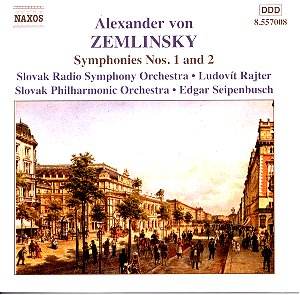These are two symphonies by an expressionist-revolutionary
writing in his ‘conformist’ twenties and keeping to the accustomed tracks
of German romanticism. Listeners must not expect any disconcerting surprises.
In the case of the First Symphony the 21-year
old had just completed his studies with Robert Fuchs. He speaks the
lingua franca of Schumann and Brahms and does so with an unhesitant
and pellucidly orchestrated discursiveness across three movements. The
style moves without effort from romantic torment (Brahms' First Symphony)
to relaxed contemplation to mellowly charming dance to ambivalent tension.
In this Zemlinsky shows none of the vitriolic wit or gargantuan orchestration
of Richard Strauss nor the originality of Mahler. The finale is extremely
lyrical - no braying horns or heroic climaxes. The orchestra is recorded
with a pleasing emphasis on the brass.
Four years later and the romantic torture has become
a degree more intense. This is a full-blown four movement symphony with
a big first movement of almost 15 minutes duration. A rolling, confident,
horn-accentuated theme of some grit dominates with a character that
now abandons Schumann and instead embraces a Brucknerian chasseur quality
with a Tchaikovsky-like glare. The ‘forest murmurs’ adagio is
troubled with malicious and benevolent sprites throwing in the occasional
frisson (as at 3.24) or smiling soliloquy. The finale shows that even
as late as 1985 the Slovak orchestra still had East European horns with
that relishably juicy vibrato. Zemlinsky seems sometimes to be about
to predict Rachmaninov's tear-soused way with romantic nobilmente and
string themes.
These are decent-to-good performances with a technical
team who have gone to some trouble to bring out the flavours of two
symphonies written in the Viennese romantic tradition. I have not heard
the recently deleted identically coupled James Conlon disc on EMI (Gürzenich
Orchestra; Kölner Philharmoniker; CDC 556473 2) but the similarly
deleted Nimbus NI 5682 with Antony Beaumont (himself a Zemlinsky scholar
of international standing) conducting the Czech Phil grips and holds
the tension; more so than Seipenbusch. The Nimbus was one of the last
gasp releases of that label before it was laid low. It is coupled with
the Prelude to Es War Einmal (1899) and the Sinfonietta (1934).
An economic way of exploring the early Zemlinsky. Both
symphonies are pleasing but the Second is more resilient when heard
repeatedly. Fascinating music and currently the only way of hearing
these two works - and at budget price too!
Rob Barnett
